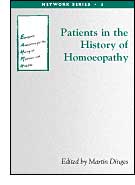
BBR Academic Bookshop Home Full Search Full Title List Place Your Order BBR Catalogue General Pages: Privacy Policy Terms of Business Help & FAQ |
Patients in the History of Homoeopathy
|
| Edition | Our Price inc. p&p | Status |
| hardback, xiv+434pp, ISBN 0953652246, 2002 | UK only: £39.95 | in stock |

|
|
|
| Other volumes in the EAHMH Network Series: |
This collection of 20 essays by leading scholars compares and contrasts the historical contexts which have led patients to choose homoeopathic practitioners. Countries under consideration include Germany, USA, France, Great Britain, Russia, Brazil, Belgium, Iceland and Denmark.
Using studies of Samuel Hahnemann's own practice, such as his approach to fees and his correspondence with patients, the book opens by challenging some of the myths surrounding the early history of homoeopathy.
Subsequent sections address issues of social standing, class and gender in the provision of homoeopathic treatment, and juxtapose the motivations of nineteenth-century and late-twentieth-century patients in their choice of healer.
Finally, the book explores the lobbying work carried out by homoeopathic patients over the past two centuries, underlining their significance as a social and political pressure group in the introduction, stabilisation and current resurgence of homoeopathy.
Contents:
- Martin Dinges, "Patients in the History of Homoeopathy"
- Robert Jütte, "'And [the money] accumulates, without annoyance on the part of the patient, in the doctor's purse': Samuel Hahnemann and the Question of Fees"
- Kathrin Schreiber, "Was Hahnemann Driven out of Leipzig? The Leipzig Practice and Why Hahnemann Moved to Köthen in 1821: Patient Numbers and Polemics"
- Michael Stolberg, "The Experience of Illness and the Doctor-Patient Relationship in Samuel Hahnemann's Patient Correspondence"
- Martin Dinges, "Men's Bodies 'Explained' on a Daily Basis in Letters from Patients to Samuel Hahnemann (1830-35)"
- Iris Ritzmann, "Children as Patients in Early Homoeopathy"
- Phillip A. Nicholls, "Class, Status and Gender: Toward a Sociology of the Homoeopathic Patient in Nineteenth-Century Britain"
- Alexander Kotok, "Patients of Russian Pre-World War I Homoeopathy"
- Sigrídur Svana Pétursdóttir, "'Patients don't care from where the cure comes': Patients' Choice of a Homoeopathic Lay Healer in Iceland"
- Anna-Elisabeth Brade, "Sören Jensen - a Danish Homoeopath, his Time and his Patients (1874-84)"
- Olivier Faure, "Léon Vannier's Patients in the 1930s"
- Marijke Gijswijt-Hofstra, "The Haverhoeks and their Patients: the Popularity of Unqualified Homoeopaths in the Netherlands in the Early Twentieth Century"
- Anne Hilde van Baal, "Homoeopathy in Nineteenth-Century Flanders: the Patients of the Ghent Homoeopath Gustave van den Berghe (1869-1902)"
- Osamu Hattori, "Co-operation and Tensions between Homoeopathic Lay Societies and Homoeopathic Doctors: the Homoeopathic Lay Movement in Württemberg during the Professionalisation of the Medical Profession, 1868-1921"
- Martina Günther and Hans Römermann, "The Homoeopathic Patient in General Practice: Findings of a Comparative Poll of Patients in Conventional Medical Practices and Homoeopathic Private and Health Insurance Scheme Practices"
- Opijucan Calixto Fraiz and Lore Fortes, "Homoeopathy from the Patient's Standpoint: an Empirical Study in the City of Curitiba (Brazil), 1998-99"
- Gunnar Stollberg, "Patients and Homoeopathy: an Overview of Sociological Literature"
- Bernard Leary, "The Influence of Patients in the Provision of Homoeopathy in Great Britain: Nineteenth and Twentieth Centuries"
- Naomi Rogers, "The Public Face of Homoeopathy: Politics, the Public and Alternative Medicine in the United States, 1900-40"
- Anne Taylor Kirschmann, "Struggle for Survival: the American Foundation for Homeopathy and the Preservation of Homoeopathy in the United States, 1920-30"
- Consolidated Bibliography
- Index
Contributors:
Anne Hilde van Baal is a PhD student at the University of Amsterdam, The Netherlands.
Anna-Elisabeth Brade is Emeritus Professor of History of Medicine at the University of Copenhagen and former director of the Medical Historical Museum, University of Copenhagen, Denmark. Her publications in the history of homoeopathy include 'Die Welt der Medizin und die Haltung derLegislative: Dänemark' in Martin Dinges (ed.), Weltgeschichte der Homöopathie. Länder, Schulen, Heilkundige (Munich, 1996).
Martin Dinges is Deputy Director of the Institute for the History of Medicine of the Robert Bosch Foundation, Stuttgart, Germany and Professor at the University of Mannheim, Stuttgart, Germany. His publications include Weltgeschichte der Homöopathie. Länder, Schulen, Heilkundige (Munich, 1996) (ed.); Homöopathie. Patienten, Heilkundige, Institutionen. Von den Anfängen bis heute (Heidelberg, 1996) (ed.); Medizinkritische Bewegungen im Deutschen Reich (c.1870-c.1933) (Stuttgart, 1996); 'The Role of Medical Societies in the Professionalisation of Homeopathic Physicians in Germany and the USA' in Robert Jütte, Guenter B. Risse and John Woodward (eds.), Culture, Knowledge, and Healing: Historical Perspectives of Homeopathic Medicine in Europe and North America (Sheffield, 1998); and 'The Contribution of the Comparative Approach to the History of Homoeopathy' in Robert Jütte, Motzi Eklöf and Marie C. Nelson (eds.), Historical Aspects of Unconventional Medicine: Approaches, Concepts, Case Studies (Sheffield, 2001).
Olivier Faure is Professor of Modern History (nineteenth and twentieth centuries) at the University of Lyon, France. Among his publications are Le débat autour de l'homéopathie en France (1830-1870): évidences et arrières-plans (Lyon, 1990); Praticiens, patients et militants de l'homéopathie aux XIXe et XXe siècles (1800-1940) (Lyon, 1992) (ed.); and Histoire de l'homéopathie (forthcoming, Paris, 2002).
Lore Fortes is a scientific collaborator at the University of Erlangen-Nürnberg, Germany, whose publications include 'Homöopathie auf dem Weg in das staatliche Gesundheitssystem: Brasilien' in Martin Dinges (ed.), Weltgeschichte der Homöopathie. Länder, Schulen, Heilkundige (Munich, 1996); 'Geschichte der Homöopathie in Brasilien und Deutschland: Ein Vergleich' in Hahnemann-Lutze Verein e.V. (ed.), Homöopathie in Köthen (Köthen, undated [1997]); and Institutionalisation of Homoeopathy in Brazil and Germany: a Sociological Analysis of the Agent's Conflicts and Convergencies (sociological dissertation, University of Brasilia, 2000).
Opijucan Calixto Fraiz is a Doctor and Lecturer at the Department of Community Health of the Federal University of Paraná, Brazil.
Marijke Gijswijt-Hofstra is Professor of Social and Cultural History, at the University of Amsterdam, The Netherlands. Among her recent publications are 'Homeopathy's Early Dutch Conquests: The Rotterdam Clientele of Clemens von Bönninghausen in the 1840s and 1850s', Journal of the History of Medicine and Allied Sciences 51:2 (1996); 'Critics and Converts of Homeopathy: the Dutch Debate in the Nineteenth Century' in Robert Jütte, Guenter B. Risse and John Woodward (eds.), Culture, Knowledge, and Healing: Historical Perspectives of Homeopathic Medicine in Europe and North America (Sheffield, 1998); and 'Conversions to homoeopathy in the nineteenth century. The rationality of medical deviance' in Marijke Gisjwijt-Hofstra, Hilary Marland and Hans de Waardt (eds.), Illness and Healing Alternatives in Western Europe (London and New York, 1997).
Martina Günther is an assistant doctor (hauseman) in a neurological clinic in the Westerwald, Germany.
Osamu Hattori is Associate Professor in the Faculty of Education of Gifu University in Japan, whose publications include Doitsu 'shirouto-Ishi' Dan (The Laymen Association in Germany - Homeopathic Social Movement) (Tokyo, 1997).
Robert Jütte is currently Director of the Institute for the History of Medicine of the Robert Bosch Foundation, Stuttgart, and Professor of History at the University of Stuttgart, Germany. His extensive publications include Geschichte der alternativen Medizin. Von der Volksmedizin zu den unkonventionellen Therapien von heute (Munich, 1996); Culture, Knowledge, and Healing: Historical Perspectives of Homeopathic Medicine in Europe and North America (Sheffield, 1998) (co-edited with Guenter B. Risse and John Woodward); and Historical Aspects of Unconventional Medicine: Approaches, Concepts, Case Studies (Sheffield, 2001) (co-edited with Motzi Eklöf and Marie C. Nelson).
Anne Taylor Kirschmann is an independent scholar and Adjunct Professor at the University of Massachusetts, Dartmouth, USA. Among her publications are 'Adding Women to the Ranks, 1860-1890: A New View with a Homeopathic Lens', Bulletin of the History of Medicine 73 (1999); A Vital Force: Women in American Homeopathy, 1850-1930 (forthcoming).
Alexander Kotok is an independent researcher based in Jerusalem, Israel. He is the author of 'Homeopathy and the Russian Orthodox Clergy: Russian Homeopathy in Search of Allies in the Second Part of the 19th and Beginning of the 20th Centuries', Medizin, Gesellschaft und Geschichte 16 (1998).
Bernard Leary, a retired General Practitioner who lives in Chesterfield, United Kingdom, has recently published 'It Won't Do Any Harm, Practice and People at the London Homoeopathic Hospital, 1889-1923' in Robert Jütte, Guenter B. Risse and John Woodward (eds.), Culture, Knowledge, and Healing: Historical Perspectives of Homeopathic Medicine in Europe and North America (Sheffield, 1998) (with Maria Lorentzon and Anna Bosanquet); and 'The Homoeopathic Management of Cholera', Medizin, Gesellschaft und Geschichte 16 (1998).
Phillip A. Nicholls is currently Head of the Department of Sociology, Staffordshire University, Stoke-on-Trent, United Kingdom. His publications include Homoeopathy and the Medical Profession (London, 1988); 'Laienpraktiker und häretische Mediziner: Grossbritannien' in Martin Dinges (ed.), Weltgeschichte der Homöopathie. Länder, Schulen, Heilkundige (Munich, 1996) (with Peter Morrell).
Sigrídur Svana Pétursdóttir is an MA Student at the University of Iceland in Reykjavik, whose publications include 'Í smáum skömmtum. Af smáskammtalækninum séra Magnúsi Jónssyni á Grenjadarstad.' ('In small doses. The homeopath rev. Magnús Jónsson in Grenjadarstad') in Gudni Halldórsson and Sigurjón Jóhannesson (eds.), Árbók Pingeyinga 1996, (Akureyri, 1996).
Iris Ritzmann is a Researcher at the Institute for the History of Medicine of the Robert Bosch Foundation, Stuttgart, Germany.
Hans Römermann is currently a paediatrician and homoeopathic general practitioner in Burg on Fehmarn, Germany.
Naomi Rogers is Lecturer in the Section of the History of Medicine at Yale University School of Medicine and in Yale's Women's and Gender Studies Program, New Haven, USA. Her work includes An Alternative Path: The Making and Remaking of Hahnemann Medical College and Hospital of Philadelphia (Rutgers, 1998); 'American Homeopathy Confronts Scientific Medicine' in Robert Jütte, Guenter B. Risse and John Woodward (eds.), Culture, Knowledge, and Healing: Historical Perspectives of Homeopathic Medicine in Europe and North America (Sheffield, 1998); and 'Women and sectarian medicine' in Rima D. Apple (ed.), Women, Health, and Medicine in America. A Historical Handbook (New York, 1990).
Kathrin Schreiber is a Houseman (intern) at the Pius-Clinic in Oldenburg, Germany. She is the author of Samuel Hahnemann in Leipzig, Förderer, Gegner, Patienten: Das soziale Netzwerk der Homöopathie zwischen 1811 und 1821 (medical dissertation, Dresden, 1997, forthcoming publication).
Michael Stolberg is Professor of History of Medicine at the Technical University in München. His publications include 'Die Homöopathie im Königreich Bayern', Medizin, Gesellschaft und Geschichte 14 (1995); 'Die Homöopathie auf dem Prüfstein. Der erste Doppelblindversuch der Medizingeschichte im Jahr 1835', Münchener medizinische Wochenschrift 138 (1996); 'Homöopathie und Klerus. Zur Geschichte einer besonderen Beziehung', Medizin, Gesellschaft und Geschichte 17 (1998); and Die Homöopathie im Königreich Bayern (1800-1914) (= Studien und Quellen zur Geschichte der Homöopathie, Vol. 5) (Heidelberg, 1999).
Gunnar Stollberg is currently Professor in the Faculty for Sociology at the University of Bielefeld, Germany, whose work includes Patientenwelten. Krankheit und Medizin vom späten 18. bis zum frühen 20. Jahrhundert im Spiegelvon Autobiographien (Opladen, 1995) (with Jens Lachmund); and 'Heterodoxe Medizin, Weltgesellschaft und Globalisierung. Asiatische Medizinformen in Westeuropa' in Gisela Brünner and Elisabeth Gülich (eds.), Kommunikation über Krankheiten (Bielefelder Schriften zur Linguistik und Literaturwissenschaft) (forthcoming).